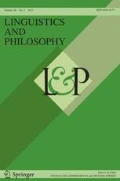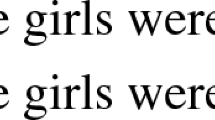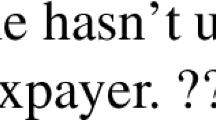Abstract
The paper argues that two distinct and independent notions of plurality are involved in natural language anaphora and quantification: plural reference (the usual non-atomic individuals) and plural discourse reference, i.e., reference to a quantificational dependency between sets of objects (e.g., atomic/non-atomic individuals) that is established and subsequently elaborated upon in discourse. Following van den Berg (PhD dissertation, University of Amsterdam, 1996), plural discourse reference is modeled as plural information states (i.e., as sets of variable assignments) in a new dynamic system couched in classical type logic that extends Compositional DRT (Muskens, Linguistics and Philosophy, 19, 143–186, 1996). Given the underlying type logic, compositionality at sub-clausal level follows automatically and standard techniques from Montague semantics become available. The idea that plural info states are semantically necessary (in addition to non-atomic individuals) is motivated by relative-clause donkey sentences with multiple instances of singular donkey anaphora that have mixed (weak and strong) readings. At the same time, allowing for non-atomic individuals in addition to plural info states enables us to capture the intuitive parallels between singular and plural (donkey) anaphora, while deriving the incompatibility between singular (donkey) anaphora and collective predicates. The system also accounts for empirically unrelated phenomena, e.g., the uniqueness effects associated with singular (donkey) anaphora discussed in Kadmon (Linguistics and Philosophy, 13, 273–324, 1990) and Heim (Linguistics and Philosophy, 13, 131–177, 1990) among others.
Similar content being viewed by others
References
Abusch D. (1994) The scope of indefinites. Natural Language Semantics 2: 83–135
Asher N., Wang L. (2003) Ambiguity and anaphora with plurals in discourse. In: Young R., Zhou Y. (eds) Proceedings of SALT XIII. CLC Publications, Ithaca, pp 19–36
Barker C. (1996) Presuppositions for proportional quantifiers. Natural Language Semantics 4: 237–259
Barwise J. (1987) Noun phrases, generalized quantifiers and anaphora. In: Gärdenfors P. (eds) Generalized quantifiers. Kluwer, Dordrecht, pp 1–29
Barwise J., Cooper R. (1981) Generalized quantifiers in natural languages. Linguistics and Philosophy 4: 159–219
Bäuerle, R., & Egli, U. (1985). Anapher, Nominalphrase und Eselssätze. Papier 105 des Sonderforschungsbereichs 99, Universität Konstanz.
Beaver D., Zeevat H. (2006) Accommodation. In: Ramchand G., Reiss C. (eds) Oxford handbook of linguistic interfaces. Oxford University Press, Oxford
Bittner M. (2007) Online update: Temporal, modal and De Se anaphora in polysynthetic discourse. In: Barker C., Jacobson P. (eds) Direct compositionality. Oxford University Press, Oxford, pp 363–404
Brasoveanu, A. (2007). Structured nominal and modal reference. PhD dissertation, Rutgers University.
Brasoveanu, A., & Farkas, D. F. (2008). Exceptional scope as discourse reference to quantificational dependencies. In Proceedings of the 7th International Tbilisi Symposium on Language, Logic and Computation (to appear).
Chierchia G. (1995) The dynamics of meaning. University of Chicago Press, Chicago
Chierchia G. (2001) A puzzle about indefinites. In: Cecchetto C., Chierchia G., Guasti M.T. (eds) Semantic interfaces: Reference, anaphora and aspect. CSLI, Stanford, pp 51–89
Chierchia G. (2006) Broaden your views: Implicatures of domain widening and the “Logicality” of language. Linguistic Inquiry 37: 535–590
Chomsky N. (1981) Lectures on government and binding. Foris, Dordrecht
Cooper R. (1979) The interpretation of pronouns. In: Henry F., Schnelle H. (eds) The nature of syntactic representations, syntax and semantics, volume 10 (Selections from the Third Gröningen Round Table). Academic Press, New York, pp 61–92
Dalrymple M., Kanazawa M., Kim Y., McHombo S., Peters S. (1998) Reciprocal expressions and the concept of reciprocity. Linguistics and Philosophy 21: 159–210
Dekker, P. (1993). Transentential meditations: Ups and downs in dynamic semantics. PhD dissertation, University of Amsterdam.
Elbourne P. (2005) Situations and individuals. MIT Press, Cambridge
Elworthy D. (1995) A theory of anaphoric information. Linguistics and Philosophy 18: 297–332
Evans G. (1977) Pronouns, quantifiers and relative clauses (I). The Journal of Canadian Philosophy 7: 467–536
Evans G. (1980) Pronouns. Linguistic Inquiry 11: 337–362
Evans G. (1985) Collected papers. Oxford University Press, Oxford
Farkas D.F. et al (1981) Quantifier scope and syntactic islands. In: Hendrik R. (eds) Proceedings of CLS 7. CLC Publications, Ithaca, pp 59–66
Farkas D.F. (2002) Varieties of indefinites. In: Jackson B. (eds) Proceedings of SALT XII. CLC Publications, Ithaca, pp 59–84
Fodor J.D., Sag I. (1982) Referential and quantificational indefinites. Linguistics and Philosophy 5: 355–398
Gallin, D. (1975). Intensional and higher-order modal logic with applications to Montague semantics. North-Holland Mathematics Studies.
Geurts B. (2002) Donkey business. Linguistics and Philosophy 25: 129–156
Groenendijk J., Stokhof M. (1991) Dynamic predicate logic. Linguistics and Philosophy 14: 39–100
Heim, I. (1982). The semantics of definite and indefinite noun phrases. PhD dissertation, UMass Amherst [published in 1988, New York: Garland].
Heim I. (1983) On the projection problem for presuppositions. In: Barlow M., Flickinger D., Wescoat M. (eds) Proceedings of WCCFL 2. Stanford University, Stanford, pp 114–125
Heim I. (1990) E-type pronouns and donkey anaphora. Linguistics and Philosophy 13: 137–177
Heim I. (1991) Artikel und Definitheit. In: Stechow A., Wunderlich D. (eds) Semantik: Ein internationales Handbuch der zeitgenössischen Forschung. Walter de Gruyter, Berlin
Heim I., Kratzer A. (1998) Semantics in generative grammar. Blackwell, Oxford
Kadmon, N. (1987). On unique and non-unique reference and asymmetric quantification. PhD dissertation, UMass Amherst.
Kadmon N. (1990) Uniqueness. Linguistics and Philosophy 13: 273–324
Kamp H. (1981) A theory of truth and semantic representation. In: Groenendijk J., Janssen T., Stokhof M. (eds) Formal methods in the study of language, Part 1. Mathematical Center, Amsterdam, pp 277–322
Kamp H., Reyle U. (1993) From discourse to logic. Introduction to model-theoretic semantics of natural language, formal logic and discourse representation theory. Kluwer, Dordrecht
Kanazawa M. (1994) Weak vs. strong readings of donkey sentences and monotonicity inference in a dynamic setting. Linguistics and Philosophy 17: 109–158
Kanazawa, M. (1994b). Dynamic generalized quantifiers and monotonicity. In M. Kanazawa & C. Pinón (Eds.), Dynamics, polarity and quantification (pp. 213–249). CSLI Lecture Notes 48. Stanford: CSLI.
Kanazawa M. (2001) Singular donkey pronouns are semantically singular. Linguistics and Philosophy 24: 383–403
Karttunen L. (1976) Discourse referents. In: McCawley J.D. (eds) Syntax and semantics, volume 7: Notes from the linguistic underground. Academic Press, New York, pp 363–385
Karttunen L., Peters S. (1979) Conventional implicature. In: Oh C.-K., Dineen D.A. (eds) Syntax and semantics: Presupposition Vol. 11. Academic Press, London, pp 1–56
Kratzer A. (1998) Scope or pseudo-scope: Are there wide-scope indefinites?. In: Rothstein S. (eds) Events in grammar. Kluwer, Dordrecht, pp 163–196
Krifka M. (1996) Pragmatic strengthening in plural predications and donkey sentences. In: Galloway T., Spence J. (eds) Proceedings from SALT VI. CLC Publications, Ithaca, pp 136–153
Krifka M. (1996) Parametric sum individuals for plural anaphora. Linguistics and Philosophy 19: 555–598
Lappin S., Francez N. (1994) E-type pronouns, i-sums and donkey anaphora. Linguistics and Philosophy 17: 391–428
Lewis D. (1975) Adverbs of quantification. In: Keenan E. (eds) Formal semantics of natural language. Cambridge University Press, Cambridge, pp 3–15
Link G. (1983) The logical analysis of plurals and mass terms: A lattice-theoretical approach. In: Bäuerle R., Schwarze C., Stechow A. (eds) Meaning, use and interpretation of language. Walter de Gruyter, Berlin, pp 302–323
May, R. (1977). The grammar of quantification. PhD dissertation, MIT.
Moltmann F. (2006) Unbound anaphoric pronouns: E-type, dynamic and structured-propositions approaches. Synthese 153(2): 199–260
Montague R. (1974) The proper treatment of quantification in ordinary English. In: Thomason R. (eds) Formal philosophy. Selected papers of Richard Montague. Yale University Press, New Haven, pp 247–270
Muskens R. (1995) Tense and the logic of change. In: Egli U., Pause P., Schwarze C., Stechow A., Wienold G. (eds) Lexical knowledge in the organisation of language. Benjamins, Amsterdam, Philadelphia, pp 147–183
Muskens R. (1996) Combining Montague semantics and discourse representation. Linguistics and Philosophy 19: 143–186
Muskens, R. (2005). Natural language semantics, ESSLLI 17th course notes, Edinburgh. Available at http://let.uvt.hl/general/people/rmuskas/courses.htm.
Neale S. (1990) Descriptions. MIT Press, Cambridge
Nouwen, R. (2003). Plural pronominal anaphora in context. PhD dissertation, Utrecht University, LOT Dissertation Series 84.
Parsons, T. (1978). Pronouns as paraphrases, UMass Amherst, ms.
Partee B., Rooth M. (1983) Generalized conjunction and type ambiguity. In: Bauerle R., Schwartze C., Stechow A. (eds) Meaning, use and interpretation of language. Walter de Gruyter, Berlin, pp 361–383
Pelletier F.J., Schubert L.K. (1989) Generically speaking or using Discourse Representation Theory to interpret generics. In: Chierchia G., Partee B.H., Turner R. (eds) Properties, types and meanings, Vol. 2. Kluwer, Dordrecht, pp 193–268
Peters S., Westerståhl D. (2006) Quantifiers in language and logic. Oxford University Press, Oxford & New York
Reinhart T. (1997) Quantifier scope: How labor is divided between QR and choice functions. Linguistics and Philosophy 20: 335–397
Roberts C. (2003) Uniqueness in definite noun phrases. Linguistics and Philosophy 26: 287–350
Rooth M. (1987) Noun phrase interpretation in Montague grammar, file change semantics and situation semantics. In: Gärdenfors P. (eds) Generalized quantifiers. Kluwer, Dordrecht, pp 237–268
Sauerland U. (2003) A new semantics for number. In: Young R., Zhou Y. (eds) Proceedings of SALT XIII. CLC Publications, Ithaca, pp 258–275
Scha, R. (1981). Distributive, collective and cumulative quantification. In J. Groenendijk, T. Janssen & M. Stokhof (Eds.), Formal methods in the study of language, Part 2 (pp. 483–512). Mathematical Centre Tracts 136, University of Amsterdam.
Schein, B. (2003). Adverbial, descriptive reciprocals. In J. Hawthorne (Ed.), Language & philosophical linguistics, philosophical perspectives 17.1 (pp. 333–367).
Schwarzschild R. (1992) Types of plural individuals. Linguistics and Philosophy 15: 641–675
Schwarzschild R. (1996) Pluralities. Springer, Dordrecht/Boston/London
Schwarzschild R. (2002) Singleton indefinites. Journal of Semantics 19: 289–314
Steedman, M. (2007). Surface-compositional scope-alternation without existential quantifiers. University of Edinburgh ms.
Stone M. (1992) Or and anaphora. In: Barker C., Dowty D. (eds) Proceeding of SALT II (OSU Working papers in linguistics 40). OSU, Columbus, pp 367–385
van den Berg, M. (1994). A direct definition of generalized dynamic quantifiers. In P. Dekker & M. Stokhof (Eds.), Proceedings of the 9th Amsterdam Colloquium. ILLC/Department of Philosophy, University of Amsterdam.
van den Berg, M. (1996). Some aspects of the internal structure of discourse. The dynamics of nominal anaphora. PhD dissertation, University of Amsterdam.
van der Does, J. (1993). The dynamics of sophisticated laziness. ILLC, University of Amsterdam, ms.
van der Sandt R. (1992) Presupposition projection as anaphora resolution. Journal of Semantics 9: 333–377
van Eijck J., de Vries F.-J. (1992) Dynamic interpretation and Hoare deduction. Journal of Logic, Language and Information 1: 1–44
von Fintel, K. (1994). Restrictions on quantifier domains. PhD dissertation, UMass Amherst.
Winter Y. (1997) Choice functions and the scopal semantics of indefinites. Linguistics and Philosophy 20: 399–467
Winter Y. (2000) Distributivity and dependency. Natural Language Semantics 8: 27–69
Author information
Authors and Affiliations
Corresponding author
Rights and permissions
About this article
Cite this article
Brasoveanu, A. Donkey pluralities: plural information states versus non-atomic individuals. Linguist and Philos 31, 129–209 (2008). https://doi.org/10.1007/s10988-008-9035-0
Received:
Accepted:
Published:
Issue Date:
DOI: https://doi.org/10.1007/s10988-008-9035-0




